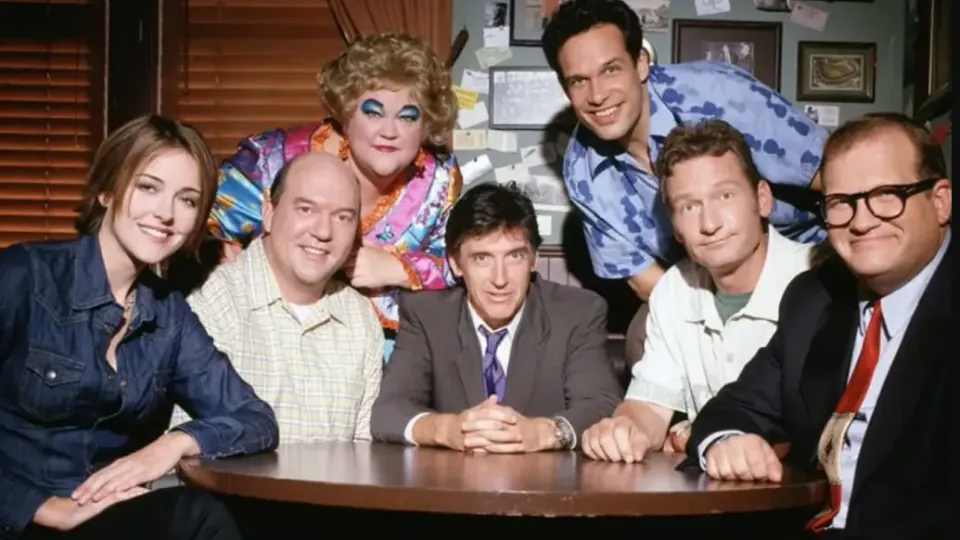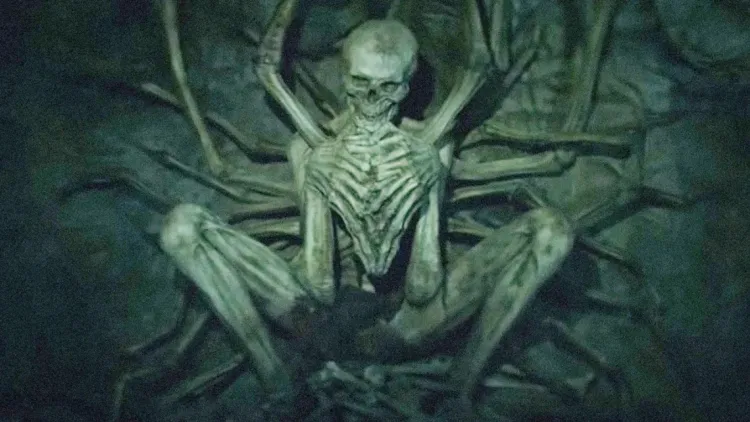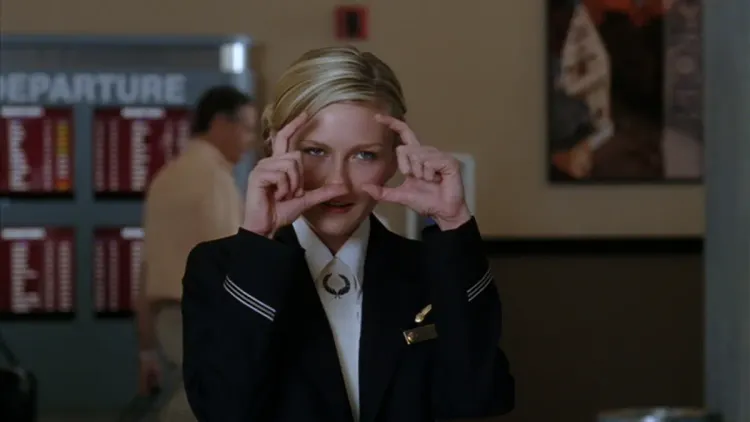The Drew Carey Show explored crossdressing — in very 1990s fashion

(Each week, I’m publishing a new pop culture essay from a freelancer. Remember: Your subscription fee helps me pay these freelancers for their efforts! This week: Chris Bouton on the now-forgotten, very 1990s, occasionally successful attempts by The Drew Carey Show to tell stories about cis man crossdressing.)
In most episodes, The Drew Carey Show, which ran from 1995-2004 on ABC, used plots and subject matter straight out of the standard sitcom playbook. The fictional Drew Carey worked as a personnel director at Winfred-Louder, a department store in Cleveland. He was surrounded by the usual cadre of sitcom sidekicks. In probably the most memorable element of the show, he had an arch-nemesis: his co-worker Mimi, who clad herself in extravagant clothes and makeup.
The Drew Carey Show hardly seemed like the place to feature a character living outside the boundaries of traditional gender roles. Yet, in the ninth episode of season three, Drew’s brother Steve (played by John Carroll Lynch) arrived at his brother’s house, thanks to a broken engagement, a lost job, and a desire for a new start. His appearance allowed the show to begin a tentative exploration of gender nonconformity — albeit in very 1990s fashion.
Drew gets Steve a job at the department store where Drew works. On Steve’s first day, Drew asks his boss to prank Steve by pretending to fire him. The show then cuts to the cosmetics department where Steve, dressed in clothing typically worn by women, applies makeup to a female customer. Steve, as the audience and a shocked Drew learn, is a crossdresser.
In the episode that follows, the show makes an honest effort to understand the roots of Steve’s crossdressing. First, after Drew’s friend Oswald asks why Steve cross-dresses, Steve replies, “Why do you go to baseball games? Why do you eat ice cream? Why do you take bike rides in the park?” Oswald answers, “Because it feels good.” Steve responds, “Well you should try it in women’s underwear. It’s unbelievable.”
In the very next scene, Steve, aware of Drew’s discomfort, arrives at the Warsaw, Drew’s favorite bar, dressed in male clothing. Drew lashes out at Steve for keeping his crossdressing secret. Steve explains that he began crossdressing in his youth but kept it to himself until leaving home. Now, however, Steve is ready to be honest about himself to his loved ones. When Drew suggests that Steve could show up to work dressed as a man. Steve replies, “That’s when I need to dress up most. When I dress up like a woman it gives me confidence.”
At various points, The Drew Carey Show, reflecting the cultural assumptions of the late 1990s, conflates Steve’s crossdressing with homosexuality and drag culture. Drew informs Steve that if he were gay, federal law would protect his jo. (Though that wasn't really true in the 1990s, we can forgive Drew for not being an expert in LGBTQ civil rights.) Later, Dionne Warwick, an artist beloved by many in the queer community, appears at the store, and the store’s manager confuses her for a man, allowing Steve to keep his job — the less said about that plot point, the better.

Yet cis man crossdressers, like Steve, are cisgender and heterosexual, and they exist independently from drag culture. However, although cis man crossdressers are not trans, they do exist within a broader spectrum of gender non-conformity that includes anyone who pushes back against the simplistic gender binary, including non-binary people, genderfluid people, and many others.
Considering this episode aired in the late 1990s, when other television shows dealt with issues like gay family members or children in the style of a very special episode, it is remarkable at all that the writers of The Drew Carey Show attempted an honest investigation into the origins and reasons for Steve’s crossdressing, however hackneyed the plotting may have been.
As Steve notes, the interest in dressing in clothing traditionally associated with women begins in youth and then accelerates in adolescence. Some crossdressers never become fully comfortable with dressing. They may be fearful of discovery or feel shame for failing to live up to societal gender expectations.
For many, the sensation of crossdressing provides a sense of calm and grounding. This feeling provides an escape from the stresses of work and competition, especially in very masculine environments. For some cis men, crossdressing allows them to feel more comfortable expressing their emotions and sharing feelings, especially when traditionally male heterosexual environments reject such outward displays of vulnerability.
The Drew Carey Show’s exploration of Steve’s crossdressing was far more nuanced than you’d expect from a show of its era. The fourth season episode “Cain and Mabel,” for instance, inadvertently stumbled onto the need for crossdressers to have safe spaces amid the ongoing threat of violence. After Drew stands up for a crossdressing Steve to a threatening, homophobic patron of the Warsaw, the bar becomes a haven for crossdressing men looking for a safe space to drink. Drew and Steve eventually get into a heated argument about how Steve has “ruined” the Warsaw, and Steve confronts Drew, saying, “You’re embarrassed I’m a crossdresser.” Drew admits his discomfort, but says his actual issue is that dating back to their childhood, “every time you see something of mine you want, you just take it.” Steve apologizes, and the two reconcile.
The Drew Carey Show did not treat the threat against Steve as anything other than a plot expediter. But violence against gender nonconforming people is frighteningly real. There is little data tracking violence against crossdressers, but the experiences of trans people provide a stark reminder of the cost that can be incurred for stepping outside the traditional gender binary. According to the 2015 U.S. Transgender Survey Report, transgender individuals “experienced harassment and violence at alarmingly high rates.”
“Cain and Mabel” raises the issue of safe spaces before quickly retreating from it. With the ever-present threat of violence, where can gender nonconforming people feel safe in public? One of Steve’s friends mentions how nice it is to have The Warsaw become a safe place to socialize.
Major metropolitan areas, with their more accepting attitudes towards gender nonconformity, are more likely to have organizations, support groups, and other avenues for crossdressers to socialize. In more rural areas, the opportunities for safe socialization are much more limited. The Cleveland of the Drew Carey Show seems to fit somewhere in-between. There are enough crossdressers in Cleveland to fill a bar, but they have no space to call their own. By the end of the episode, however, the show wraps everything up in a tidy bow. Drew and Steve have settled their differences, the Warsaw’s regular blue-collar clientele has returned, and the crossdressers and their justifiable concerns about safety have disappeared back into hiding – never to be heard or seen from again on the show.
While Steve’s crossdressing continues to be a minor plot point in the fourth season, the show begins to move away from telling stories about his crossdressing when Steve starts dating Mimi. The two begin dating after Mimi sees Steve dressed in male attire at Drew’s house. When Steve arrives to their date in women’s clothing, Mimi is upset. The pair, however, succumb to their desires — with Steve dressed up. Their relationship continues to deepen across season four, as Steve continues to cross-dress.

In the fifth-season premiere, however, Steve appears dressed in normal male clothes. His lack of crossdressing goes uncommented upon by the other cast members. From that point onward, there are occasional jokes about Steve’s crossdressing, but when he marries Mimi in the middle of the fifth season, he wears a tuxedo. In a throwaway line of dialogue, Steve eventually admits to giving up crossdressing as a concession to Mimi. This is quite a turn for a character who received three separate coming-out scenes — to Drew in Winfred-Lauder, to his father disguised as a stripper in a bachelor party cake, and to the rest of his family in Drew’s backyard.
Steve’s abandonment of his crossdressing reflects the real-life experience of many crossdressers. Some partners begrudgingly accept crossdressing, so long as it occurs outside of the household or they themselves do not have to participate in it. Some partners of crossdressers find the act of crossdressing upsetting and simply want their husbands to be “normal” and to conform to traditional gender roles. They don't understand why their husbands can't simply stop crossdressing. They will give their partners a choice — their relationship or their crossdressing. This view treats crossdressing as a behavior in need of correction, rather than an immutable part of a person’s identity.
Such negative responses to crossdressing can be emotionally devastating for a crossdresser. The rejection of a core part of one’s identity can lead to depression, anger, and purging — the throwing away of clothes, makeup, and other items out of guilt. Some cis man crossdressers decide that it is better to throw away their clothes, bury that part of themselves, and accept traditional gender roles as much as possible.
This pressure to adhere to heteronormative values imprints itself on cis man crossdressers before they even have their first urges to cross-dress. From youth, they’ve internalized the societal idea that girls are sensitive, shy, and emotional, and that boys are natural leaders who hide their emotions, especially from others. Those stereotypes aren't true, of course, but they're drilled into everyone from an early age, forming the backbone of the societal expectations all gender non-conforming people flout. So when a crossdresser begins dressing, they are aware that they are breaking gender taboos, which gives some crossdressers, like Steve, the freedom and confidence to share their true selves with others.
That level of honesty and emotional vulnerability can lead some heterosexual couples to an even deeper connection. They dress up together, share clothes, pick out clothes for one another, and may even go out together. These accepting partners of crossdressers, recognizing the courage it takes to share such a potentially shameful secret, are thankful for their partner’s openness. Yet, like other gender nonconforming people, cis man crossdressers struggle to find partners willing to cast aside the constraints of traditional gender roles and accept them for who they are.
Within the world of this 1990s sitcom, Steve’s abandonment of his crossdressing is an about-face for a character who arrived on the show confident and secure in his gender identity. This security, ironically, limited any further exploration of Steve’s crossdressing. After all, Steve’s journey to accept himself occurred before he ever arrived in Cleveland. These formative experiences — fraught with accidental discoveries by parents and loved ones, rejection by family and partners, and the discovery and forging of an identity that falls outside the traditional gender binary — are rife with comedic and dramatic possibility. The show, with its traditional sitcom roots, however, instead paired Steve off with Mimi, the other character with an exaggerated and unconventional appearance.
By pairing Steve with Mimi and eliminating his crossdressing, the Drew Carey Show reverted to the gender status quo. Early in the fifth season, as Steve and Mimi prepare for their wedding, they undergo religious counseling. They plan to be married by a priest and Steve exclusively wears suits and other male clothing. Now entrenched as Mimi’s husband and Drew’s brother, Steve simply becomes a useful plot vehicle for sitcom antics between the show’s primary antagonists. By removing Steve’s gender nonconformity, the character had nowhere to go except back to staid heteronormativity.
Episodes is published twice per week. Mondays alternate between a free edition on various topics and a subscriber-supported edition where I recap TV shows of interest. Fridays offer pop culture thoughts from freelance writers. The Friday edition and the biweekly recaps are only available to subscribers. Suggest topics for future installments via email or on Twitter. Read more of my work at Vox.





Member discussion